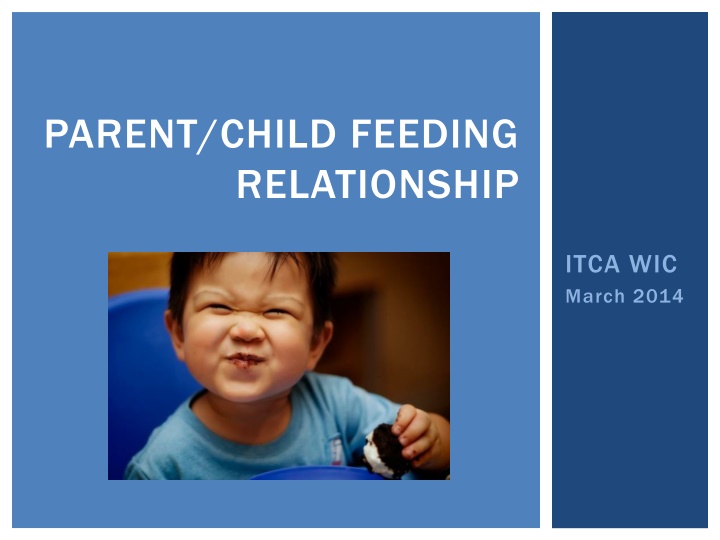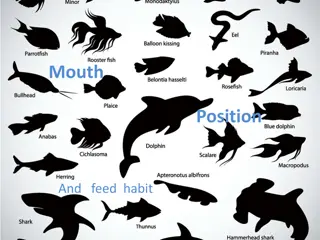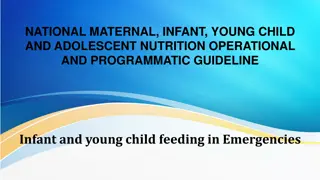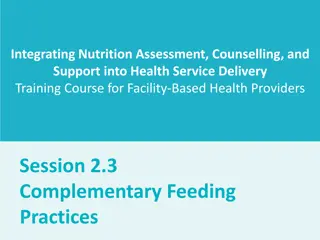
Successful Strategies for Positive Parent-Child Feeding Relationships
Learn how to navigate common mealtime conflicts, encourage healthy eating habits, and foster a positive feeding relationship with your child. Discover the division of responsibility in feeding, caregiver roles, and ways to empower children in making food choices.
Download Presentation

Please find below an Image/Link to download the presentation.
The content on the website is provided AS IS for your information and personal use only. It may not be sold, licensed, or shared on other websites without obtaining consent from the author. If you encounter any issues during the download, it is possible that the publisher has removed the file from their server.
You are allowed to download the files provided on this website for personal or commercial use, subject to the condition that they are used lawfully. All files are the property of their respective owners.
The content on the website is provided AS IS for your information and personal use only. It may not be sold, licensed, or shared on other websites without obtaining consent from the author.
E N D
Presentation Transcript
PARENT/CHILD FEEDING RELATIONSHIP ITCA WIC March 2014
Learn how to help our families solve common meal-time conflicts and make meal and snack times with their kids fun and healthy. SUMMARY OBJECTIVES Topics that will be covered: Roles for the caregiver and child Appropriate vs inappropriate foods for kids How to handle/provide NE for common scenarios Counseling strategies for caregivers of overweight/underweight children Sample handouts and tips to utilize them Sample goals/ways to meet goals
OUR GOALS SHOULD BE TO RAISE A CHILD WHO Likes eating and feels good about it Is interested in food Likes being at the table Relies on internal hunger cues and fullness to know how much to eat
GOALS, CONT. Enjoys many different foods Can try new foods and learn to like them Can turn down foods politely Can make do with less than favorite foods
WHAT ARE SOME COMMON CONFLICTS? I m not hungry/I don t want to eat. I m hungry now. I don t like that. I want [cereal] please. See what a good eater I am? I want to do it myself.
WHOS IN CHARGE? Are kids under 5 old enough to plan a menu? Or go grocery shopping?
DIVISION OF RESPONSIBILITY WHO DECIDES WHAT? Caregiver decides: What is served (what to eat) When it is served (when to eat) Where food is served (where to eat) Children decide: If they will eat. How much they will eat.
CAREGIVER ROLES DETAILS CAREGIVERS ARE RESPONSIBLE FOR: Controlling what food comes into the house Making and presenting meals Insisting that children show up for meals Making meals pleasant
CAREGIVER ROLES CONT. CAREGIVERS ARE RESPONSIBLE FOR: Teaching children to behave at the table Regulating timing and content of snacks Making other rules (no standing at the refrigerator door, no candy before dinner, etc.) Other rules?
CAREGIVERS ARE NOT RESPONSIBLE FOR http://swimmom.files.wordpress.com/2008/01/bordifamily-053b.jpg How much the child eats Whether the child eats How the child s body turns out Scenario: Sally is worried about how much soda her overweight son is drinking. What actions are appropriate for her to take?
HOW MUCH SHOULD KIDS EAT? Guidelines are available, but we don t really know Children s brains/bodies tell them how much they should eat Eating needs vary from child to child and from day to day What about children who are overweight or underweight? Any difference in responsibilities?
APPROPRIATE FOODS Low/No added sugar/salt Nutrient content Texture Variety Portion size
COMMON ISSUES Asks for something else Cautious about foods Never seems hungry Only likes one or two foods Only wants junk food/drinks
NUTRITION EDUCATION Cautious about foods 1. Offer a familiar food along with 1 or 2 new foods 2. New foods in small amounts 3. Offer a choice between two new foods 4. Encourage child to at least try it 5. Mix it in with something familiar
NUTRITION EDUCATION Asks for something else 1. Offer two choices of what is available or has been served. 2. Let her help make/serve the meal. 3. Serve the food and let her decide if she will eat or not. 4. Offer a small amount of the preferred food if it is available.
NUTRITION EDUCATION Never seems hungry 1. How much milk/juice/other drinks are they having, and when? 2. What is their feeding schedule like set times vs grazing? 3. Have him sit at the table with the others. 4. Offer meals/snacks every 2-3 hours.
NUTRITION EDUCATION Only likes 1 or 2 foods 1. If it is a healthy food, may offer it often-once a day or a small amt more often. 2. If it is unhealthy, do not buy it/bring it in the house. 3. Offer other foods along with the favorite.
NUTRITION EDUCATION Only wants junk food https://encrypted-tbn1.gstatic.com/images?q=tbn:ANd9GcSGuTRg9B7jlfR0SCmO6HMCwKkGvmnqu62wh8t45lz4VDHm0ga9 1. Avoid purchasing. 2. Avoid letting kids see you eat them. 3. Be a good role model eat with your child. Let them see you eat healthy.
NUTRITION EDUCATION Eats only small amounts 1. How much milk/juice/other drinks are they having, and when? 2. What is their feeding schedule like set times vs grazing? 3. Do the parents know what an appropriate portion size is? 4. Do not make a big deal about whether the child eats or not. Just offer a variety of healthy foods at set times.
SAMPLE HANDOUTS Picky Eaters Is your child a picky eater? Juice Healthy Snack Options Make snack time fun and healthy The F/V guide to good TASTE for kids! Other Fit WIC Newsletters
SAMPLE GOALS Problem: Child just wants to drink milk and juice and is never hungry. Goal: Limit juice and milk. Ways to meet: 1. Starting tomorrow, only offer milk and juice with meals and one snack. 2. Offer water at with other snacks and between meals.
SAMPLE GOALS Problem: Child doesn t like to try new foods. Goal: Encourage new foods. Ways to meet: 1. Offer one new food at meal times along with foods the child does like. 2. Start at dinner today and do this for every meal.
SAMPLE GOALS Problem: Child doesn t eat so caregiver gives whatever the child wants so she ll eat something. Goal: Encourage healthier eating. Ways to meet: 1. Serve the same foods to the entire family. 2. Let your child serve herself out of the foods that are offered. OR Offer a choice of 2 items. 3. Serve the food and don t make a big deal about it if she eats it or not. 4. Try this for at least 2 weeks starting this week.
SAMPLE GOALS Problem: Child only wants junk food. Goal: Encourage healthier eating. Ways to meet: 1. Starting this week, at meal times serve the types of foods you want your child to eat. 2. For one snack out of the day, serve a small portion of the junk food your child likes along with some healthier snack options. 3. Do not buy junk foods when you go grocery shopping.
SAMPLE GOALS Problem: Child doesn t like any vegetables. Goal: Encourage vegetables. Ways to meet: 1. Ask the child to pick out vegetables on your grocery list when you re shopping. 2. Let your child help prepare the vegetables they picked out. 3. As a snack/art project make fun faces out of small pieces of vegetables with your child once a week.
SAMPLE GOALS Problem: Child only picks at his food and doesn t eat a whole meal. Goal: Offer regular meals/snacks. Ways to meet: 1. Offer 3 meals and 2-3 snacks a day so he has a chance to eat every 2-3 hours. 2. Do not offer foods or drinks except water between those times. 3. It s ok if your child does not want to eat, he has his next meal or snack in 2-3 hours.






















